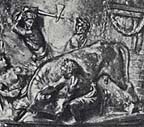 By Paul Zanker
By Paul Zanker
"At the same time as his 'restoration of the Republic' and the creation of his new political style, Augustus also set in motion a program to 'heal' Roman society. The principal themes were renewal of religion and custom, virtus, and the honor of the Roman people. Never before had a new ruler implemented such a far-reaching cultural program, so effectively embodied in visual imagery; and it has seldom happened since. A completely new pictorial vocabulary was created in the course of the next twenty years. This meant a change not only in political imagery in the narrow sense, but in the whole outward appearance of the city of Rome, in interior decoration and furniture, even in clothing. It is astonishing how every kind of visual communication came to reflect the new order, how every theme and slogan became interwoven. Again, however, there was no master plan outlining some sort of a propaganda campaign for the revival of Rome. As in the development of imagery after Actium, much happened as if of its own accord, once the princeps had shown the way and taken the first steps.
Augustus did not need to formulate a new program himself; it had already been done for him. For generations the ills of state and society had been proclaimed, described, and lamented as incurable evils. The surprising thing, for many people virtually a miracle, was that the new ruler actually took the lament seriously and decided to do something about it. He was utterly irrepressible as he set about addressing, in terms of concrete policies, all the problems that he had himself decried back in the 30s B.C., immediately creating the foundation on which he would build his programs. In the next sections we shall observe the remarkable confidence--one might almost say naivete--with which he went about building on that framework, step by step, going through the whole catalog of ills left over from the Late Republic, until in 17 B.C. he could sail the rebuilt ship of state into a safe harbor called the Golden Age.
It started with the program of religious revival in 29 B.C. There followed efforts toward publica magnificentia and the restoration of Roman virtus in the Parthian campaign of 20 B.C. Two years later, in 18, with the Romans’ confidence in their ability to rule an empire now bolstered, a legally imposed moral renewal was required. This completed the internal overhaul of Rome, and nothing now stood in the way of the new Golden Age. Nothing could be simpler!
At first, of course, each of these points in the Augustan program amounted to little more than one of the old slogans. They were statements of intention, which then had to be realized in action and in architecture and the visual arts. The princeps would need the help and cooperation of many. Since no written source gives us a picture of how the complex machinery of this cultural program actually worked, we must try to infer from the results themselves an idea of the collaboration and the mutual influence on one another of princeps, political cronies, creative poets, architects, and artistic ateliers."
No comments:
Post a Comment